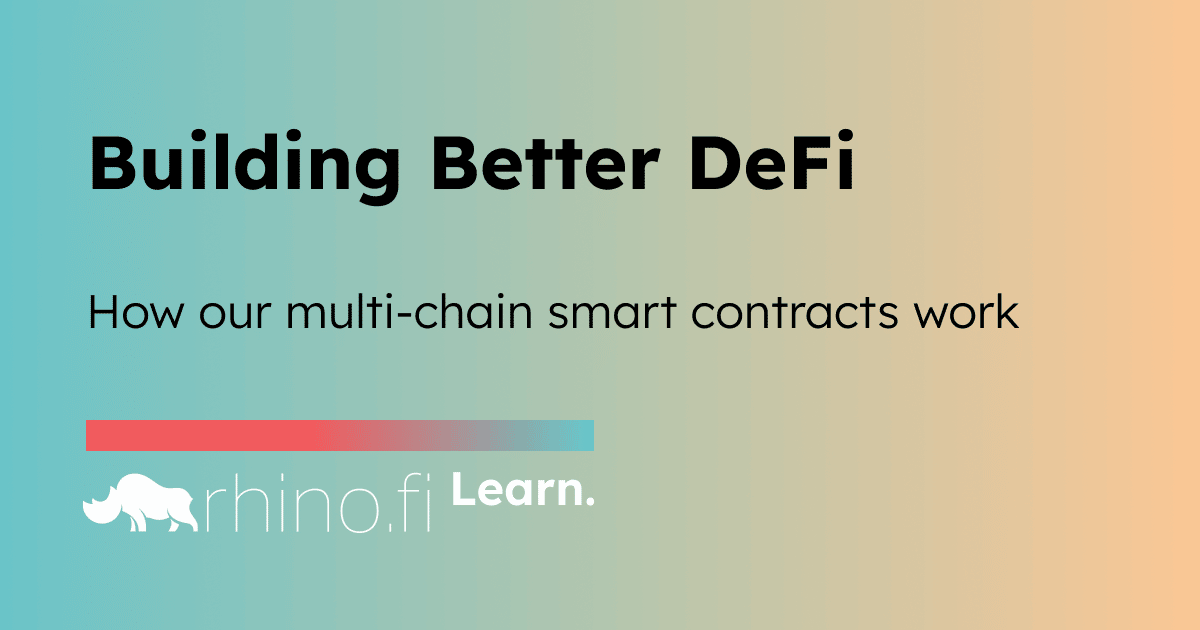Security is DeFi’s biggest challenge right now. Hacks are increasing and the rise of multi-chain technology is creating new pain-points, chiefly around bridges.
At rhino.fi, we believe the safest way to facilitate cross-chain and multi-chain transactions is by establishing liquidity outposts on different chains and making the trades on your behalf, using smart contracts that can only be triggered with your permission.
Our Ethereum rollup, developed with our scalability partner, StarkWare, acts as a router: you transfer tokens to and from StarkEx, so you don’t have to bridge and transact directly on other chains.
Since we find and deal with the bridging for you, there’s no need to worry about whether a new bridge you are trying is safe from hacks, or whether you might get your funds stuck. What’s more, the smart contracts where your funds are held can be updated for new chains, so we can continue adding the most interesting DeFi opportunities for you.
This allows us to fulfil our mission as a DeFi aggregator, adding new chains seamlessly as and when the best opportunities emerge.
We built this model when we launched cross-chain swaps to Polygon, back when we were still called DeversiFi, and have continued to tweak and hone it following our rebrand as rhino.fi (and our transformation into a DeFi aggregator platform).
Why we decided to do this
Previously, our users could only swap tokens that were available on StarkEx, the Ethereum rollup we developed with StarkWare. If they wanted to buy a token that was only available on Polygon, Arbitrum, or Avalanche, they needed to first withdraw to that chain, and then make a swap on another exchange or aggregator.
We wanted to expand our Swap interface, so that if a token was only available on another platform, such as Polygon (via Quickswap, for example) we could allow the user to buy it directly from our UI in one click.
Our solution: A smart wallet
On each chain, we have built a smart wallet that holds native tokens. Effectively, this wallet is a cross-chain smart contract, and it acts like a bank (although without the banker in the middle, of course). It holds funds for many different users under each user’s own address.
Crucially, only the user can instruct the contract to spend their funds, and the wallet has a simple withdraw function, allowing users to withdraw their assets at any time back to their account on another chain. This ensures full self-custody.
Since the wallet was created, we’ve branched it to allow two forms of user trigger:
- Swap with funds that are currently on another chain.
- Swap with funds that are already on the destination chain.
When a user signs a request to swap, they send us the message, allowing us to trigger and pay the fees for the swapOnBehalfOfUser function. This allows rhino.fi to submit swaps that the user requests and make them wherever the best price exists. This could be via an exchange like Quickswap or, more likely, via an aggregator such as Paraswap.
Case 1: Funds coming from another chain
In this case, the user gives us USDT/USDC on StarkEx and we bridge this USDT/USDC to a secondary chain (for example, Polygon). On Polygon we can swap with and bridge the user’s USDT/USDC using our own collateral, then execute the swap through Paraswap.
Funds returned by the swap (destination token) are stored in the smart wallet under the user’s address, thus achieving self-custody. This operation is atomic past the bridge.
Case 2: Funds already on the destination chain
In case 2, the user signs a message with a set of swap parameters:
- Token to give.
- Token to receive (has to be USDT/USDC).
- Amount to give.
- Amount to receive.
- Deadline.
Since the funds are already in the contract on the correct chain, we then call SwapWithUserSignature to execute this swap through Paraswap based on the parameters above. The contract validates the signature and if it does not match, the transaction reverts.
Ok, want a deeper dive into our code?
No worries. Here’s a full breakdown of our cross-chain contract, and you can also check out an early example if you want more info.
For more coding advice, just reach out to us on Reddit, Twitter or Discord and we’ll put you in touch with one of our devs.
If you have any other questions about our evolution as a DeFi aggregator and what this means, check out the post we wrote before Christmas. In fact, our Blog and Learn sections have loads of stuff about our platform, from basic wallet connection guides to advanced stuff about our latest chains as well as our swap, yield and investment opportunities.
And of course, if you want to try out our app, then go right ahead.
Read More: rhino.fi









 Bitcoin
Bitcoin  Ethereum
Ethereum  Tether
Tether  XRP
XRP  Solana
Solana  USDC
USDC  Dogecoin
Dogecoin  Cardano
Cardano  TRON
TRON  Lido Staked Ether
Lido Staked Ether  Wrapped Bitcoin
Wrapped Bitcoin  Sui
Sui  Chainlink
Chainlink  Avalanche
Avalanche  Stellar
Stellar  LEO Token
LEO Token  Toncoin
Toncoin  Hedera
Hedera  Shiba Inu
Shiba Inu  Wrapped stETH
Wrapped stETH  USDS
USDS  Bitcoin Cash
Bitcoin Cash  Litecoin
Litecoin  Polkadot
Polkadot  Hyperliquid
Hyperliquid  Monero
Monero  Binance Bridged USDT (BNB Smart Chain)
Binance Bridged USDT (BNB Smart Chain)  WETH
WETH  Bitget Token
Bitget Token  Ethena USDe
Ethena USDe  Pi Network
Pi Network  WhiteBIT Coin
WhiteBIT Coin  Wrapped eETH
Wrapped eETH  Coinbase Wrapped BTC
Coinbase Wrapped BTC  Pepe
Pepe  Aptos
Aptos  Uniswap
Uniswap  Dai
Dai  Bittensor
Bittensor  OKB
OKB  Official Trump
Official Trump  NEAR Protocol
NEAR Protocol  Ondo
Ondo  Gate
Gate  Internet Computer
Internet Computer  sUSDS
sUSDS  Aave
Aave  BlackRock USD Institutional Digital Liquidity Fund
BlackRock USD Institutional Digital Liquidity Fund